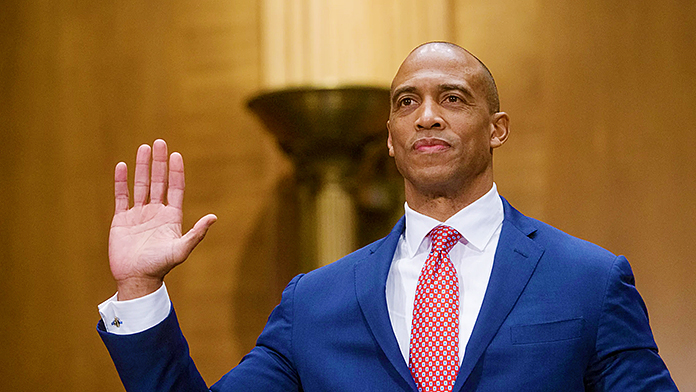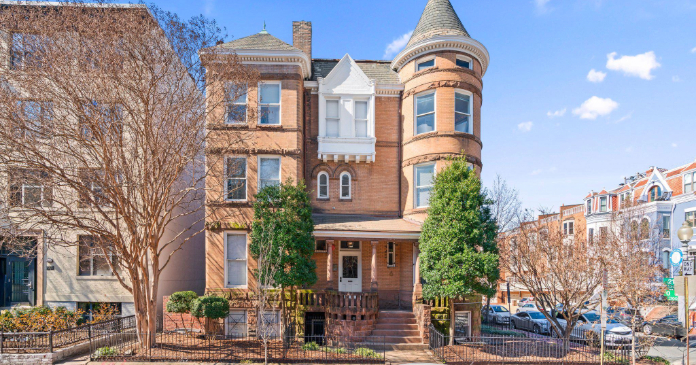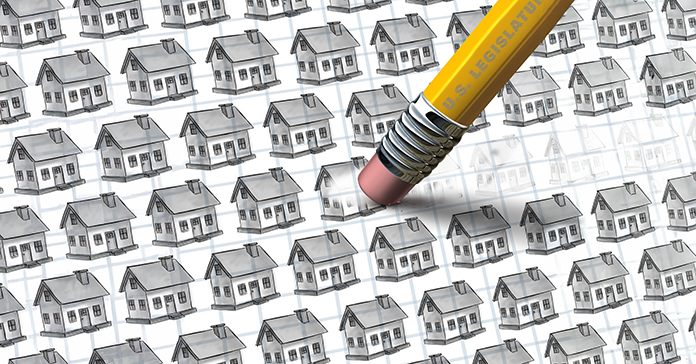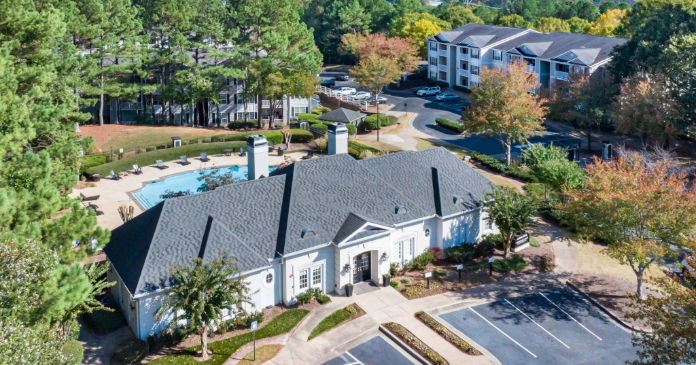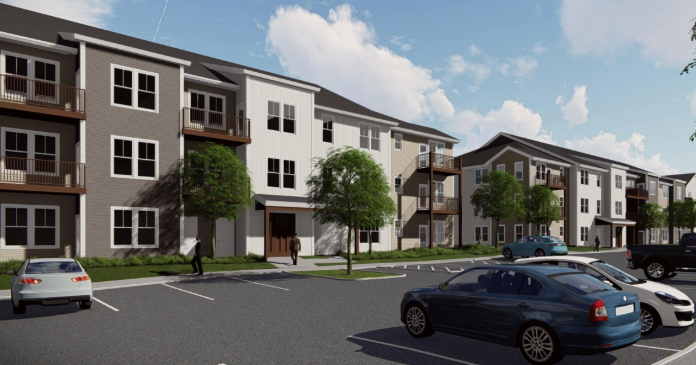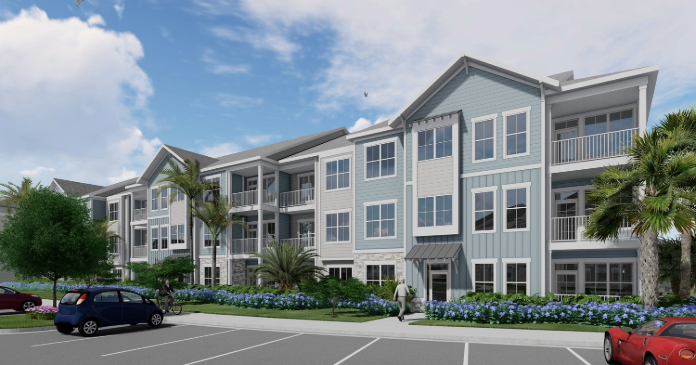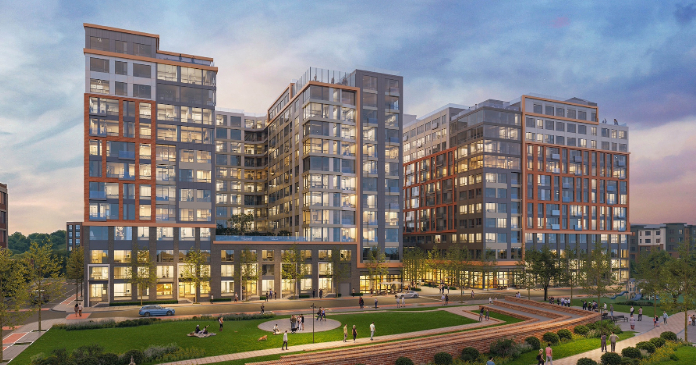Between September 2006 and May 2007, the fifth largest multifamily REIT in the country purchased nine tired apartment communities that housed 2,184 units in Addison, all of which will be demolished sequentially to make way for the complete renovation of a deteriorating neighborhood, turning the city’s dream makeover into a reality.
“I never thought I’d live to see it happen. I didn’t think anyone would ever be able to come in and assemble all the property,” Ron Whitehead, Addison’s city manager since 1982, said in early July. And UDR CEO Tom Toomey called it a “once in a corporate lifetime development opportunity,” at the ground-breaking last spring.
UDR Sr. VP of Development Mark Culwell agrees that such a chance happens only once in a blue moon. “It would be remarkable to duplicate it in some other market,” he said. “It’s a pretty rare find when you can aggregate 100 acres in a central part of a major metropolitan area, gain all the entitlement approvals, secure the assets in an aggregation and close them and be ready to come out of the ground within a 24-month period,” Culwell said, crediting UDR VP of Development Tom Lamberth, and the Dallas-based development team Lamberth leads, for laying the foundation for the project with such alacrity.
City and resident support
The project also gained traction thanks to Addison’s efficient entitlement process and the city officials’ enthusiasm for UDR’s plan to create a high-density, sustainable product that is expected to include around 200,000 sq. ft. each of office and retail space within easy walking distance of the residential elements, embellished with lush landscaping, a 12-acre park with a spring-fed creek adorned with waterfalls and bridges, which will be built as part of the first phase. A couple of other parks, playing fields and an amphitheater will enhance later phases over the next eight to 10 years.
Along with blessing the project conceptually, Addison is contributing $40 million for infrastructure improvements, $24 million of which is currently being dispersed to kick-start the redevelopment of the area with road and water and sewer rehab, with the second funding of $16 million to come later, mostly for park development.
“And we really had overwhelming support from not only the council and the city staff, but from the general population of Addison,” Lamberth said of the town that suffers from an unusual dearth of housing.
The airport factor
Addison Airport, completed in 1957 and purchased by the town in 1986, and now the third largest general aviation airport in the country, is located in the middle of the small city, rendering much of the property in town inappropriate for housing. “We have only 15,000 people who live here and we bring 150,000 people into the city for work on a daily basis,” the city manager explained last month. More than 11 million sq. ft. of office space, 4,000 rooms in 22 hotels, one million sq. ft. of upscale shopping and 170 restaurants, more restaurants per capita than anywhere in Texas, are located within the borders of the 4.3-square-mile city.
“Vitruvian Park is the type of high-quality development envisioned by Addison leadership and demanded by our growing residential and business population, as well as our numerous visitors,” said Joe Chow, Addison’s mayor since 2005, at the ground-breaking for the project that is the largest development ever undertaken by UDR.
Addison has been committed to rebuilding the crumbling infrastructure in the aging Brookhaven neighborhood for many years and had some money in the bank for rehab of a portion of the neighborhood’s water system even before UDR purchased its first asset on Brookhaven Club Road. But a vast project like Vitruvian was not part of UDR’s vision when Lamberth and his team bought the 36-year-old, 382-unit Greenhaven Village in September 2006 through the company’s taxable REIT subsidiary RE3, viewing the asset as a “kind of a renovation deal,” Lamberth said.
However, as the team studied the Brookhaven neighborhood surrounding Greenhaven, a more comprehensive plan began to evolve, resulting in the decision to acquire the rest of the apartments on the south side of Brookhaven Club Drive to gain some control of the project’s destiny there. “After we were successful in doing that, we began to look to the north side of the street and decided it made sense to create some momentum to change the entire neighborhood,” Culwell recalled.
The apartment communities in the Brookhaven neighborhood mostly lacked local ownership. Capital investment had dwindled and deterioration had accelerated over the previous 10 to 15 years. The average income of the residents was very low at most of the properties, resulting in an overcrowding of units well past normal occupancy standards to provide enough wage earners to pay the rent, adding to the burden on city services like police, fire and education.
In order to effect real change, Culwell said, “We decided we ought to acquire some of the apartments across the street. Tom approached the first seller and it ended up that they were the guys who owned three different assets there and, once those fell into place, we decided, ‘Let’s go get the rest of it.'”
The wedding of like minds
It was at that point that the public/private partnership of UDR and Addison was conceived.
Whitehead recalls, with some amusement, how the first meeting with UDR came about through a chance meeting with a lawyer, whose firm had done some work for both Addison and UDR. They met outside of their mutual church one Sunday morning in early in 2007 and the lawyer told the city manager that a company he worked for had purchased some apartment communities on Brookhaven Club Drive and would like to talk with him.
“So, we made an appointment and we all sat down and we told them we already had plans to rebuild the main street through the project and to redo the water lines and, if this were a bigger project, we’d be willing to put money into the infrastructure,” he said of the area that mainly consisted of old product that had been rehabbed about six times and was beyond further rehab. Much of it was built before the city was well established and a lot of it had been built in the flood plain. “We had a number of interests. We needed new product, and we needed a lot of the old product to come out of those environmentally sensitive areas,” he said.
“When UDR came in, we were excited because they obviously had a strong commitment to sustainable development and we had felt for a long time that we needed to create more urban housing to accomplish our goals of sustainability by keeping people close to home and work, so it was kind of a natural fit,” said Whitehead. It was that mutual vision that prompted the city to provide financial support for the project.
That participation comes from the sale of certificates of obligation, a debt mechanism that frequently is used to finance infrastructure improvements. The certificates are backed by the city’s pledge to levy whatever property tax rate is needed to repay the debt. The city issued $23.5 million in certificates of obligation to build the streets, parks and utility lines related to the first phase of Vitruvian Park’s development. It is anticipated that the property tax revenue generated by the new construction will offset the cost of servicing the debt within seven years. The money is not a gift to the developer because the rebuilt streets and sidewalks and water and sewer lines and the new parks for which the funds are earmarked will be owned and maintained by the city.
“It’s a great marriage. We have a lot of common goals and, by using both of our money wisely, we can benefit each other and, thus, the public,” said the city manager.
Experience paved the way
By happy coincidence, Addison already had experience with development of a 100-acre mixed-use community within its boundaries, said Whitehead. Just about 12 years before that first meeting with UDR, the founders of Columbus Realty Trust–former Dallas Cowboy center Robert Shaw and former quarterback Roger Staubach–broke ground on Addison Circle, one of the pioneers in development of urban product in suburban locations, giving the city an opportunity to focus on its first pedestrian-oriented development.
The city already had the site for such a project on its radar, but the land was owned by Oklahoma Publishing Company, controlled by the Gaylord family that also owns numerous hotels across the country.
Columbus Realty was known for its successful urban projects in the Dallas area, so the city officials asked Shaw and Staubach to take a look at the site and “tell us if we were crazy,” recalled the city manager. “They said, ‘Well, you’re not crazy, but we can’t build urban product without your participation. So, if we’re going to do this, we need you to participate in the infrastructure.'”
The city fathers agreed and contributed around $9 million to development of basic infrastructure for Addison Circle, adding another $4 million to $5 million over the years, mostly for park development for the mixed-use community that now includes 2,220 dwelling units with a wide variety of floor plans and price points to accommodate a vast spectrum of residents, 600,000 sq. ft. of office, 120,000 sq. ft. of retail and restaurants and more than 25 acres of parks and green space, probably more, on a percentage basis, than in any other New Urbanism project in Texas and, perhaps, the nation, Whitehead explained.
“And we’re trying to do the same thing at Vitruvian,” he said, adding that UDR’s project may have even more green space per acre than the project that preceeded it, all of which will be dedicated to the town, as is the park land in Addison Circle.
“Vitruvian Park is the same model we used for Addison Circle. Our whole philosophy, which worked well there, was that two things were important. One was to have the development rules in place and the second was to have infrastructure in place. So it didn’t make any difference to us who the developer was, because we built our infrastructure and the infrastructure’s not going anywhere and we own it.”
In late 1997, apartment REIT Post Properties Inc. acquired Columbus Realty Trust for around $600 million. Among the assets acquired in that transaction were the 300-unit Phase I that Columbus Realty built of the community that Post Properties renamed Post Addison Circle, along with the partially-built Phase II and the land that eventually included subsequent phases of Post Addison Circle, which now consists of 1,350 apartments. Several years after the merger of Columbus and Post, Shaw, whose company’s headquarters today is located in a high- rise office building in Addison Circle, founded Amicus Partners and built the 86-unit, seven-story Aventura condominiums in the district.
Around four years ago, Dallas-based, veteran single-family home builder Centex started a 183-unit, three-story, townhouse-style condo community, dubbed District A, under the company’s CityHomes brand in the district. The last one of those condos sold on August 2.
And, just down the street, Fairfield Residential LLC delivered first units in July at the 414-unit 15777 Quorum apartment community that borders Addison Circle Park on three sides and is scheduled for completion in January 2009. Phoenix-based SNK Realty Group broke ground for the 272-unit Allegro Addison about a year ago in the district, with plans to deliver first units in the fall at the community that also will include nearly 3,000 sq. ft. of ground floor retail.
Despite numerous different developers building there over the past dozen years, the city never has worried about Addison Circle’s future because, as with Vitruvian, control of the infrastructure insulates Addison’s investment from risk.
UDR’s risk armor
Toomey frequently has said that development is the riskiest of REIT multifamily activities, so he and his development team have made certain that UDR is insulated from risk with several armor-clad strategies, the first being the location of the site near the intersection of the North Dallas toll road and the LBJ Freeway, within eight miles of more than 20 million sq. ft. of office space, much of it filled with high-paying jobs. The area is home to the headquarters of companies like Pizza Hut, Mary Kay Cosmetics, Pepsi and Frito-Lay, that also park their planes at the city’s airport.
Love Field and D/FW airport are less than 30 minutes away. Galleria Dallas is close by and Downtown Dallas is just 15 minutes down the road.
Working with the city, UDR has obtained the rights to triple the residential density on the property, and build as much as 500,000 sq. ft. each of office and retail, “which we really count as gravy,” UDR EVP Mark Wallis explained to an analyst who asked, during the REIT’s NAREIT conference presentation in early June, about the risk factor involved with taking on a $1 billion project. “Simply stated, it’s a $100 million investment in income-producing apartments, which we will phase out over seven years,” he said, adding, “Really, the $1 billion is sort of the upside of the transaction because we anticipate bringing in a JV partner,” with promise of the promotes, developer fees and management income that go along with a joint venture arrangement and will grow with delivery of each new phase.
“So we view this as a deal where the downside protection is we’re not forced to roll out phases immediately because we do have income- producing assets on the property,” he said, adding that UDR already has increased the occupancy at the five still-operating assets, which have received some cosmetic interior and exterior improvements, especially the assets scheduled for demolition late in the construction that is expected to be completed by 2017.
“We will go about this prudently, thoughtfully and carefully, delivering it phase by phase, as the market justifies it. We will be discerning in the product that we deliver. We think this product will appeal to a wide variety of customers, so we’ll provide a variety of product and price-points to appeal to those different market segments. We can afford to be patient,” Culwell agreed, during his presentation at UDR’s second annual Investor Day in June.
The company also can afford to be patient in the pursuit of a JV partner for Vitruvian Park because UDR is under no time constraints or pressure to raise cash. The $1.7 billion sale of nearly one-third of the company’s portfolio, which closed last March, left UDR with a younger, more strategically located portfolio of apartments, and also flush with cash and able to fund development needs without help.
The REIT’s executives view the current economic environment as an indicator that this is a less than ideal time to strike a deal. “We prefer to let things settle down to be sure we are acting in the best interest of share owners,” said UDR VP of Investor Relations Larry Thede of the pursuit of a partner aligned with the company’s strategic vision, willing to work with UDR over the long term and interested in additional future ventures.
Phase I of VI
The company plans to go vertical this summer on the 669-unit first phase on the former Greenhaven site, starting with 392 units and followed by 250 units that will start about six months later. The new apartments will range from 499 sq. ft. to 1,375 sq. ft. and are expected to rent for $700 to $1,800. Delivery of first units is expected at the beginning of 2010.
Across all six phases of the project, the retail component likely will be ground-floor, below residential or office, although a free-standing retail element could possibly be included by the time the project gets into its final phases. The office portion will work much the same, except that the current plan does include at least one free- standing office building, Culwell explained in July, adding that the latter stage of the development might even see retail on the ground floor with office and residential above in some combination.
The assemblage
The first two assets purchased–Greenhaven Village and the 630- unit, 31-year-old The Addison at Brookhaven, that was acquired a month later, occupying 21.5 and 23.7 acres, respectively, on either side of the creek that runs through the property–have been demolished. Of the other seven apartment communities, which occupy sites ranging from four to nine acres, the 104-unit, 33-year-old The Brooks Apartments that was purchased in March 2007 and the 240-unit, 39-year-old Greenbrook Apartments UDR bought a month or two later, have been vacated. The remaining five assets, all of which were added to the assemblage in Q2 and Q3 2007–the 181-unit, 31-year-old Garden Oaks apartments; the 260-unit, 30-year-old Clipper Point, the 168-unit, 33-year-old Glenwood Apartments and the youngest of the bunch, the 29-year-old, 184-unit Springhaven Apartments–remain operating properties that will be demolished to make way for the fourth through sixth phases of the development.
All of the previous owners were private, entrepreneurial types, only two of them locally based. And Greenhaven Village was the only Brookhaven property on the market when UDR bought it. “We had to knock on the doors for the rest of them, with the help of Jeff Price, a broker with the Apartment Group office in Dallas,” said Lamberth.
Each asset was a little harder to buy than the previous ones, as the owners figured out what was going on, “but, at the same time, it was pretty congenial the whole way and, frankly, the area had run down a little bit and they were wondering what their exit strategy might be when we came knocking on their doors, so we were welcomed in pretty quickly,” he said.
“It was an opportune time to sell and it worked well for those folks,” Culwell added. “At that point, cap rates were still compressed and it was probably as good a selling environment as they were going to see, so they capitalized on that.”
Based on the ancients
Mindful of the ancient principles of Vitruvius, the First Century Roman architect who wrote 10 books about appropriate scale in urban environments and the relationship between man and his environment that still are used in architecture classes today, UDR’s sustainable community is designed to embrace the concept of human scale.
Vitruvian Man, Leonardo da Vinci’s drawing that depicts the scale of the human being to his own body and in relationship to his environment and embodies the Renaissance genius’ advocacy of sensitivity to the natural environment, also helped inspire the name of the community for which renowned planner Kevin Sloan of Kevin Sloan Studio in Dallas created a human-centric layout. The traffic- calming design that features wide sidewalks and proximity to the interior main street is intended to encourage pedestrians to move about freely and efficiently within the retail and residential areas.
Outdoor seating and convenient parking locations also are incorporated into the overall plan to encourage pedestrian mobility.
Built for the future
Vitruvian is Addison’s most recent major sustainable green initiative, harmonizing perfectly with the developer’s commitment to building environmentally responsible communities that is echoed in UDR’s recently redesigned green-hued logo and tag line, “Opening doors to the future.” The entire project will be developed in accordance with LEED certification standards and Addison’s own recently created hybrid of Energy Star and LEED standards intended to maximize efficiency and minimize environmental impact.
“We are committed at UDR to sustainable development. As our customers become more conscious of green initiatives, we believe they’ll pay a premium for that and, more importantly, we believe it’s just the right, responsible thing to do as developers,” Cullwell said during his June Investor Day presentation.
UDR’s Sr. VP of Operations Jerry Davis agreed, citing results of a poll of 64,000 UDR past and current residents, via email, that had received some 1,800 responses by the beginning of June. Some 67 percent of those respondents said they would pay an additional $20/month in rent if UDR could cut their utility costs by $20.
The application of the company’s green initiative at Vitruvian begins with the demolition of the old assets. The demolition waste will be sorted onsite by type and product and disposed of by appropriate recyclers. The tear-down and abatement costs will average around $5,000/unit.
UDR won’t reuse any of that material in the construction of the project, but has saved some trees and other landscaping from the first demolition sites and plans to continue that policy. “We’ve parked them over in kind of a tree farm on our site and will redeploy them when the new development is built,” Lamberth explained.
Other green elements planned for the construction include low-VOC- emitting building materials and 14 SEER HVAC systems, energy-efficient windows, rainwater catchment systems, parking garages and decks with outlets to support electric cars. Careful arrangement of the buildings on the property to take advantage of sunlight in the winter months and shade in the summer months, an efficient irrigation system for watering the indigenous plants that will make up the landscaping that may extend to roof gardens, also will benefit the environment and Vitruvian’s future residents.
Always in the top 10
Dallas has always been an active transaction market for the REIT and Thede expects UDR will always have a presence there, buying and selling and building as market cycles dictate and opportunities arise. It’s the company’s tenth largest market, currently generating 4 percent of UDR’s NOI.
“Even though Vitruvian Park is a big project, it will be done over a number of years and we plan to joint venture some of it, so it’s likely that the Dallas percent of the total portfolio won’t change dramatically from where it is now,” Thede predicted. “It probably always will be in our top 10, but probably not in our top five,” he said of the market where the REIT currently owns a total of 5,495 units that include the 1,987 in the not-yet-demolished Vitruvian Park assets and the recently completed 1,043-unit, three-property portfolio of apartments that UDR acquired early this year on the south side of Legacy Town Center in West Plano from residential developer Columbus Realty Partners, of which Shaw is CEO and president. UDR’s $916 million Dallas area development pipeline of 6,903 units includes 5,500 at Vitruvian; the $19 million, 200-unit second phase of Riachi at One21 in Plano, and the $29 million, 289- unit Mustang Park, a pre-sale deal with Lincoln Property Company.
Both Riachi and Mustang Park are underway and scheduled for completion in 2009. The $63 million, 465-unit Belmont will rise on a site UDR has assembled near Uptown Dallas. A hybrid that’s partly Texas-wrap along with some surface parking in an urban-style environment, Belmont is expected to start in Q3 2008 with completion in 2010.
As of the end of June, UDR owned 43,045 apartments with average monthly rent approaching $1,200 in 20 markets arrayed across the country in what Toomey likes to describe as a smile that begins in Seattle, runs down the West Coast to San Diego, then across the country through Phoenix, Dallas, Austin and Nashville to Florida, where it turns up the East Coast, ending in Baltimore. Orange County, Calif., is the REIT’s top market, with Metro Washington D.C. and the San Francisco Bay area UDR’s second and third best markets.




